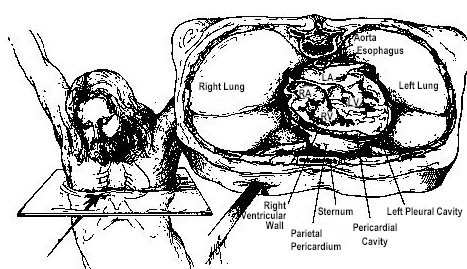 |
|
| Spear wound to chest.
Left, Probable path of spear. Right, Cross section of thorax, at level of plane
indicated at left, showing structures perforated by spear. LA indicates left
atrium; LV, left ventricle; RA, right atrium; RV, right ventricle. 7nbsp; |
|
|
Here, Jesus' clothes, except for a linen loincloth, again were removed, thereby probably reopening the scourging wounds. He then was offered a drink of wine mixed with myrrh (gall) but, after tasting it, refused the drink. (1) Finally, Jesus and the two thieves were crucified. Although scriptural references are made to nails in the hands (1), these are not at odds with the archaeological evidence of wrist wounds, since the ancients customarily considered the wrist to be a part of the hand. (7,11) The titulus was attached above Jesus' head. It is unclear whether Jesus was crucified on the Tau cross or the Latin cross; archaeological findings favor the former (11) and early tradition the latter. (38) The fact that Jesus later was offered a drink of wine vinegar from a sponge placed on the stalk of the hyssop plant (1) (approximately 20 in, or 50 cm long) strongly supports the belief that Jesus was crucified on the short cross. The soldiers and the civilian crowd taunted Jesus throughout the crucifixion ordeal, and the soldiers cast lots for his clothing. (1) Christ spoke seven times from the cross. (1) Since speech occurs during exhalation, these short, terse utterances must have been particularly difficult and painful. At about 3 PM that Friday, Jesus cried out in a loud voice, bowed his head, and died. (1) The Roman soldiers and onlookers recognized his moment of death. (1) Since the Jews did not want the bodies to remain on the crosses after sunset, the beginning of the Sabbath, they asked Pontius Pilate to order crucifracture to hasten the deaths of the three crucified men. (1) The soldiers broke the legs of the two thieves, but when they came to Jesus and saw that he was already dead, they did not break his legs. (1) Rather, one of the soldiers pierced his side, probably with an infantry spear, and produced a sudden flow of |
blood and water. (1) Later that day, Jesus' body
was taken down from the cross and placed in a
tomb. (1) DEATH OF JESUS Two aspects of Jesus' death have been the source of great controversy, namely, the nature of the wound in his side (4,6) and the cause of his death after only several hours on the cross. (13-17). The gospel of John describes the piercing of Jesus' side and emphasizes the sudden flow of blood and water. (1) Some authors have interpreted the flow of water to be ascites (12) or urine, from an abdominal midline perforation of the bladder. (15) However, the Greek word (pleura (32,35,,36) used by John clearly denoted laterality and often implied the ribs. (6,32,36) Therefore, it seems probable that the wound was in the thorax and well away from the abdominal midline. Although the side of the wound was not designated by John, it traditionally has been depicted on the right side. (4) Supporting this traditions is the fact that a large flow of blood would be more likely with a perforation of the distended and thin-walled right atrium or ventricle than the thick-walled and contracted left ventricle. Although the side of the wound may never be established with certainty, the right seems more probable than the left. Some of the skepticism in accepting John's description has arisen from the difficulty in explaining, with medical accuracy, the flow of both blood and water. Part of this difficulty has been based on the assumption that the blood appeared first, then the water. However, in the ancient Greek, the order of words generally denoted prominence and not necessarily a time sequence. (37) Therefore, it seems likely that John was emphasizing the prominence of blood rather than its appearance preceding the water. |
| Back | Next |